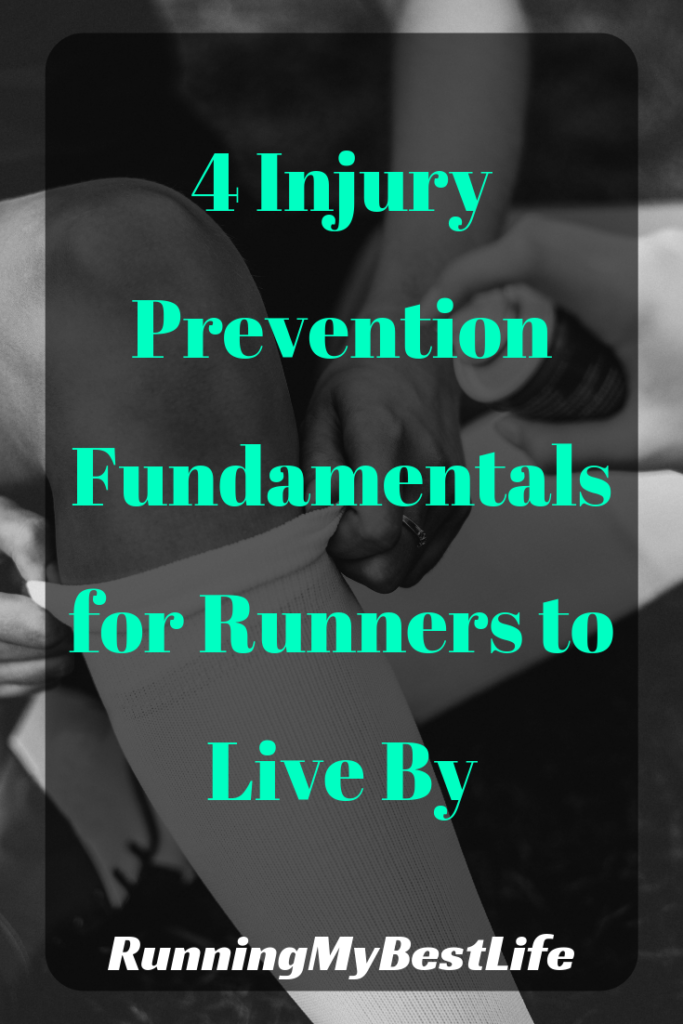Active injury prevention is imperative for runners.
In any given 12-month period, 8 out of 10 runners are likely to experience injury from overuse.
8 out of 10!! You know what that means?
Unless you are very intentional about safe training practices, you are extremely likely to be sidelined or held up by a PREVENTABLE injury.

Follow These 4 Training Rules for Overuse Injury Prevention
Thankfully, running injuries ARE preventable! Best practices for increasing mileage, improving fitness, and training runners has evolved over time to include several rules that runners live by if they want to avoid injury and keep their training consistent.
The 10% Rule
Don’t increase your weekly training mileage by more than 10% each week. Sometimes, even increasing 10% each week is too much. When in doubt, you’re always better to increase your mileage more slowly.
What does this look like in practice?
If you currently run 10 miles per week, you should not run more than 11 miles the following week. If you currently run 20 miles per week, you should not run more than 22 miles the following week.
Newer runners who decide to train for a full or half marathon should be especially careful about this rule if you don’t have a solid base of running built up before you start your training plan. Especially in the full marathon distance, mileage tends to increase quickly each week to get you to the full 20 mile long run before your marathon.
Be careful and be smart. Take rest when your body needs it and be sure your plan includes the next rule.
Take a Periodic Step-Back Week
Along with the 10% rule, a step-back week is an important tool in your injury prevention plan. Reduce your training load every 3-4 weeks to allow your body to fully recover.
This rule is critical in allowing your body to gain fitness. Training plans follow the premise of progressive overload, which means that you increase the duration and/or intensity over time to expand your body’s capacity to do lots of hard work.
However, this only works when you take a step-back week every so often to allow your body to fully recover from the training demands so it can come back stronger the next time. Without this break, you push your body to the brink of injury, and it will inevitably result in injury.
Reduce your training by 30-50% during your step-back week. This will give you some time to heal and be ready to push forward the following week. Step-back weeks are one of the reasons you should always prepare with a slightly longer training plan whenever possible. For example 12 weeks instead of 8 weeks for a half marathon, and 16 weeks instead of 12 weeks for a full marathon.
Most training plans available will incorporate a step-back week every few weeks during your training progression. You can always grab a copy of my Running Workout Tracker and manually change your training plan to include step-back weeks.
[convertkit form=878335]
The 80/20 Rule
There is a serious injury risk when you incorporate too much speed work in your training week. It’s temping to do, because with busy schedules we want to get the most out of every workout.
The Catch-22 is this: If you push yourself to the brink in every workout, you’ll put yourself on the guaranteed path to injury and burnout faster than you can say “80/20 Rule”.
The premise behind the 80/20 Rule is this: Run 80% of your weekly miles at a slow, conversational, easy pace. Don’t try to be a hero or push to a moderate pace. Run the other 20% of your weekly miles at a challenging, intense pace (usually some type of Speed Workout).
For more information on this rule, you can read my full 80/20 Running article, or grab a copy of Matt Fitzgerald’s book, 80/20 Running.
Balance and Support Your Body with Strength Training
Don’t worry, you’re not going to get “bulky” by doing strength training.
However, strength training is a critical element to preparing your body to support the demand that running creates. By employing weight training, you can correct muscle imbalances and improve your running form.
Further, you increase your muscle’s fatigue resistance, allowing you to maintain good running form for longer during your runs. By keeping your muscles strong and your body in alignment, you drastically reduce your risk for injury.
Some of the most important areas for runners to train are core, hip, and leg strength to keep your pelvis and lower-extremity joints properly aligned during each stride.

How to Get Started with Strength Training and Running Overuse Injury Prevention
Decide when you are going to incorporate strength training into your schedule, and then make time for it. Strength training doesn’t have to be your entire workout. You can add strength moves to the end of your shorter runs to save time and make sure you still get all of your training runs in.
After you decide WHEN you are going to strength train, you need to decide WHAT you will be doing during each session. If you fail to plan your exercises, then you’re more likely to skip the strength part of your workout.
Need some strength exercise ideas?
Enter your email below to grab a FREE download of “5 Strength Moves Every Runner Should Be Doing” to get you started.
[convertkit form=1015226]
If you would rather just have a complete, easy-to-follow program quickly set-up for you so you can just look at your checklist and do the workout, my friend Bethany at How to Run Guide made a fantastic course where you can grab a 28-Day Strength Program!
The 28-Day Strength Program has all of the exercises you need to do for 28 Days AND the Enhanced version includes a printable workout journal and checklists so you can track your progress through the month! PLUS, she even throws in videos of each exercise to make sure you’re doing your moves correctly.
For me, I’ve found that it is SO MUCH EASIER to take the guess work out of strength training and have a plan written out ahead of time.
If you’re not sure how to put a plan together that maximizes your time and minimizes likelihood of injury, then Bethany’s 28-Day Strength Program is the perfect starting point for you!
What injury prevention habits to you incorporate to maintain a consistent running schedule?

Run Happy,
Alexis
- Nailing Your Marathon Hydration Strategy: A Comprehensive Guide
- Conquering Marathons in the Cold: A Comprehensive Guide
- Harnessing the Power of Technology for Successful Marathon Training
- Mastering the Marathon: The Ultimate Guide to Nutrition and Training
- Ultimate Guide to the Top 5 Running Shoes for Beginners in 2023
About Me: I’m Alexis, Founder of RunningMyBestLife! I am an avid recreational runner, half marathoner, wife, dog mom, busy professional, downhill skier in Northern Utah. My mission is to help new enthusiasts fall in love with the sport of running. I believe that running is a catalyst to taking control of your life and living your best life by design. Learn More –>